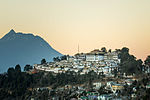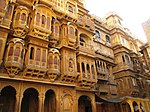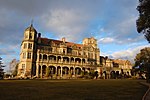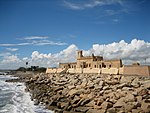Culture of India
| Part of a series on the |
| Culture of India |
|---|
 |
Indian culture is the heritage of social norms and technologies that originated in or are associated with the ethno-linguistically diverse India, pertaining to the Indian subcontinent until 1947 and the Republic of India post-1947. The term also applies beyond India to countries and cultures whose histories are strongly connected to India by immigration, colonisation, or influence, particularly in South Asia and Southeast Asia. India's languages, religions, dance, music, architecture, food, and customs differ from place to place within the country.
Indian culture, often labelled as a combination of several cultures, has been influenced by a history that is several millennia old, beginning with the
Many elements of Indian culture, such as Indian religions, mathematics, philosophy, cuisine, languages, dance, music, and movies have had a profound impact across the Indosphere, Greater India, and the world. The British Raj further influenced Indian culture, such as through the widespread introduction of the English language,[8] and a local dialect developed.
Religious culture
India has 28
India is the birthplace of
India is one of the most religiously and ethnically diverse nations in the world, with some of the most deeply religious societies and cultures. Religion plays a central and definitive role in the lives of many of its people. Although India is a secular Hindu-majority country, it has a large Muslim population. Except for Jammu and Kashmir, Punjab, Meghalaya, Nagaland, Mizoram and Lakshadweep, Hindus form the predominant population in all 28 states and 8 union territories. Muslims are present throughout India, with large populations in Uttar Pradesh, Bihar, Maharashtra, Kerala, Telangana, Andhra Pradesh, West Bengal and Assam; while only Jammu and Kashmir and Lakshadweep have majority Muslim populations. Christians are other significant minorities of India.
Because of the diversity of religious groups in India, there has been a history of turmoil and violence between them. India has been a theatre for violent religious clashes between members of different religions such as Hindus, Christians, Muslims, and Sikhs.[35] Several groups have founded various national-religious political parties, and in spite of government policies minority religious groups are being subjected to prejudice from more dominant groups in order to maintain and control resources in particular regions of India.[35]
According to the 2011 census, 79.8% of the
Philosophy
Indian philosophy comprises the philosophical traditions of the
The main schools of Indian philosophy were formalized chiefly between 1000 BCE to the early centuries of the
Family structure and marriage
For generations, India has had a prevailing tradition of the
In a 1966 study, Orenstein and Micklin analysed India's population data and family structure. Their studies suggest that Indian household sizes had remained similar over the 1911 to 1951 period. Thereafter, with urbanisation and economic development, India has witnessed a break up of traditional joint family into more nuclear-like families.[58][59] Sinha, in his book, after summarising the numerous sociological studies done on the Indian family, notes that over the last 60 years, the cultural trend in most parts of India has been an accelerated change from joint family to nuclear families, much like population trends in other parts of the world. The traditionally large joint family in India, in the 1990s, accounted for a small percent of Indian households, and on average had lower per capita household income. He finds that joint family still persists in some areas and in certain conditions, in part due to cultural traditions and in part due to practical factors.[58] Youth in lower socio-economic classes are more inclined to spend time with their families than their peers due to differing ideologies in rural and urban parenting.[60] With the spread of education and growth of economics, the traditional joint-family system is breaking down rapidly across India and attitudes towards working women have changed.
Arranged marriage
|
|
Arranged marriages have long been the norm in Indian society. Even today, the majority of Indians have their marriages planned by their parents and other respected family members. In the past, the age of marriage was young.[61] The average age of marriage for women in India has increased to 21 years, according to the 2011 Census of India.[62] In 2009, about 7% of women got married before the age of 18.[63]
In most marriages, the bride's family provides a dowry to the bridegroom. Traditionally, the dowry was considered a woman's share of the family wealth, since a daughter had no legal claim on her natal family's real estate. It also typically included portable valuables such as jewelry and household goods that a bride could control throughout her life.[64] Historically, in most families the inheritance of family estates passed down the male line. Since 1956, Indian laws treat males and females as equal in matters of inheritance without a legal will.[65] Indians are increasingly using a legal will for inheritance and property succession, with about 20 percent using a legal will by 2004.[66]
In India, the divorce rate is low — 1% compared with about 40% in the United States.
Opinion is divided over what the phenomenon means: for traditionalists, the rising numbers portend the breakdown of society while, for some modernists, they speak of healthy new empowerment for women.[70]
Recent studies suggest that Indian culture is trending away from traditional arranged marriages.
Wedding rituals

Weddings are festive occasions in India with extensive decorations, colors, music, dance, costumes and rituals that depend on the religion of the bride and the groom, as well as their preferences.[73] The nation celebrates about 10 million weddings per year,[74] of which over 80% are Hindu weddings.
While there are many festival-related rituals in Hinduism, vivaha (wedding) is the most extensive personal ritual an adult Hindu undertakes in his or her life.
Festivals
-
Andhra.
-
Color drenchedKrishna Temple, Mathura
-
Procession of the famous “Lalbaug cha Raja” Ganesha idol during the Ganesh Chaturthi festival in Mumbai, Maharashtra
-
Vallamkali snakeboat races are a part of Onamfestival tradition.
-
Dahi Handi, aMumbai, India
-
Durga Puja is a multi-day festival in Eastern India that features elaborate temple and stage decorations (pandals), scripture recitation, performance arts, revelry, and processions.[81]
-
The Hornbill Festival, Kohima, Nagaland. The festival involves colourful performances, crafts, sports, food fairs, games and ceremonies.[82]
-
Rath Yatra celebration a major festival in Puri.
-
Carnival in Goa or Viva Carnival is a Celebration prior to fasting season of Lent. It refers to the festival of carnival, or Mardi Gras, in the Indian state of Goa.
-
Gommateshwara statue during the Grand Consecration Mahamastakabhisheka in August 2018 at Shravanabelagola, Karnataka. Mahamastakabhisheka is held every 12 years and it is considered Jainism's one of the most auspicious festival or celebration.

India, being a multi-cultural, multi-ethnic and multi-religious society, celebrates holidays and festivals of various religions. The three
India celebrates a variety of festivals due to the large diversity of India. Many religious festivals like Diwali (Hindu) Eid (Muslim) Christmas (Christian), etc. are celebrated by all. The government also provides facilities for the celebration of all religious festivals with equality and grants road bookings, security, etc. providing equality to the diverse religions and their festivals.
The Indian New Year festival is celebrated in different parts of India with a unique style at different times.
Certain festivals in India are celebrated by multiple religions. Notable examples include
Christianity in India is the third-largest religion with over 27.8 million Christians, according to India's 2011 census.[84] With over 27.8 million Christians, of which 17 million are Roman Catholics, India is home to many Christian festivals. The country celebrates Christmas and Good Friday as public holidays.[83]
Regional and community fairs are also a common festivals in India. For example, Pushkar Fair of Rajasthan is one of the world's largest markets of cattle and livestock.
Greetings
Indian greetings are based on Añjali Mudrā, including Pranāma and Puja.
Greetings include Namaste (Hindi,Sanskrit and Kannada), Nômôskar in

Other greetings include Jai Jagannath (used in
), etc.These traditional forms of greeting may be absent in the world of business and in India's urban environment, where a handshake is a common form of greeting.[88]
Animals
| |||
The varied and rich wildlife of India has a profound impact on the region's popular culture. Common name for wilderness in India is jungle which was adopted by Britons living in India to the English language. The word has been also made famous in The Jungle Book by Rudyard Kipling. India's wildlife has been the subject of numerous other tales and fables such as the Panchatantra and the Jataka tales.[89]
In Hinduism, the cow is regarded as a symbol of ahimsa (non-violence), mother goddess and bringer of good fortune and wealth.[90] For this reason, cows are revered in Hindu culture and feeding a cow is seen as an act of worship. This is why beef remains a taboo food in mainstream Hindu and Jain society.[91]
The Article 48 of the Constitution of India is one of the Directive Principles which directs that the state shall endeavor to prohibit slaughtering and smuggling of cattle, calves and other milch and draught cattle.[92][93] As of January 2012, cow remains a divisive and controversial topic in India. Several states of India have passed laws to protect cows, while many states have no restrictions on the production and consumption of beef. Some groups oppose the butchering of cows, while other secular groups argue that what kind of meat one eats ought to be a matter of personal choice in a democracy. Madhya Pradesh enacted a law in January 2012, namely the Gau-Vansh Vadh Pratishedh (Sanshodhan) Act, which makes cow slaughter a serious offence.[94]
Gujarat, a western state of India, has the Animal Preservation Act, enacted in October 2011, that prohibits the killing of cows along with buying, selling and transport of beef. In contrast, Assam and Andhra Pradesh allow butchering of cattle with a fit-for-slaughter certificate. In the states of West Bengal and Kerala, consumption of beef is not deemed an offence. Contrary to stereotypes, a sizeable number of Hindus eat beef, and many argue that their scriptures, such as Vedic and Upanishadic texts do not prohibit its consumption. In southern Indian state Kerala, for instance, beef accounts for nearly half of all meat consumed by all communities, including Hindus. Sociologists theorise that the widespread consumption of cow meat in India is because it is a far cheaper source of animal protein for the poor than mutton or chicken, which retail at double the price. For these reasons, India's beef consumption post-independence in 1947 has witnessed a much faster growth than any other kind of meat; currently, India is one of the five largest producers and consumers of cattle livestock meat in the world. A beef ban has been made in Maharashtra and other states as of 2015. While states such as Madhya Pradesh are passing local laws to prevent cruelty to cows, other Indians are arguing "If the real objective is to prevent cruelty to animals, then why single out the cows when hundreds of other animals are maltreated?"[95][96][97]
Cuisine
Indian food is as diverse as India. Indian cuisines use numerous ingredients, deploy a wide range of food preparation styles, cooking techniques, and culinary presentations. From salads to sauces, from vegetarian to meat, from spices to sensuous, from bread to desserts, Indian cuisine is invariably complex. Harold McGee, a favourite of many Michelin-starred chefs, writes "for sheer inventiveness with the milk itself as the primary ingredient, no country on earth can match India."[98]
I travel to India at least three to four times a year. It's always inspirational. There is so much to learn from India because each and every state is a country by itself and each has its own cuisine. There are lots of things to learn about the different cuisines – it just amazes me. I keep my mind open and like to explore different places and pick up different influences as I go along. I don't actually think that there is a single state in India that I haven't visited. Indian food is a cosmopolitan cuisine that has so many ingredients. I don't think any cuisine in the world has got so many influences on the way that Indian food has. It is a very rich cuisine and is very varied. Every region in the world has its own sense of how Indian food should be perceived.
—Michelin stars[99]
... it takes me back to the first Christmas I can remember, when the grandmother I hadn't yet met, who was Indian and lived in England, sent me a box. For me it still carries the taste of strangeness and confusion and wonder.

According to
India is known for its love of food and spices. Indian cuisine varies from region to region, reflecting the local produce, cultural diversity, and
Despite this diversity, some unifying threads emerge. Varied uses of spices are an integral part of certain food preparations and are used to enhance the flavour of a dish and create unique flavours and aromas. Cuisine across India has also been influenced by various cultural groups that entered India throughout history, such as the

Indian cuisine is one of the most popular cuisines across the globe.[105] In most Indian restaurants outside India, the menu does not do justice to the enormous variety of Indian cuisine available – the most common cuisine served on the menu would be Punjabi cuisine (chicken tikka masala is a very popular dish in the United Kingdom). There do exist some restaurants serving cuisines from other regions of India, although these are few and far between. Historically, Indian spices and herbs were one of the most sought after trade commodities. The spice trade between India and Europe led to the rise and dominance of Arab traders to such an extent that European explorers, such as Vasco da Gama and Christopher Columbus, set out to find new trade routes with India leading to the Age of Discovery.[106] The popularity of curry, which originated in India, across Asia has often led to the dish being labeled as the "pan-Asian" dish.[107]
Regional Indian cuisine continues to evolve. A fusion of East Asian and Western cooking methods with traditional cuisines, along with regional adaptations of fast food are prominent in major Indian cities.[108]



The cuisine of
Clothing
Traditional clothing in India greatly varies across different parts of the country and is influenced by local culture, geography, climate, and rural/urban settings. Popular styles of dress include draped garments such as
Indian women perfect their sense of charm and fashion with makeup and ornaments.
-
Illustration of different styles ofgagra choli and shalwar kameezworn by women in India
-
The Didarganj Yakshi (3rd century BCE) depicting the dhoti wrap
-
Rajasthan, India
-
Anmekhela sador, 2010 and bindion the centre of her forehead.
-
Indian actressexposing the midriff and navel, which has long been a fashion with Indian women in popular culture[117]
-
Sikh man and women wearing Turban
-
J. L. Nehru wearing Nehru jacketand Chooridar.
-
Maharani Gayatri Devi, in Nivi sari. The Nivi style drape was created during the colonial era of Indian history in order to create a fashion style which would conform to the Victorian-era sensibilities
-
Malayali lady wearing Mundum neriyatum. Painted by Raja Ravi Varma, c. 1900.
-
Nocte Nagacouple in their traditional attire
Languages and literature
History
|
|
The Sanskrit language, whatever be its antiquity, is of a wonderful structure; more perfect than the Greek, more copious than the Latin, and more exquisitely refined than either, yet bearing to both of them a stronger affinity, both in the roots of verbs and the forms of grammar, than could possibly have been produced by accident; so strong indeed, that no philologer could examine them all three, without believing them to have sprung from some common source, which, perhaps, no longer exists; there is a similar reason, though not quite so forcible, for supposing that both the Gothic and the Celtic, though blended with a very different idiom, had the same origin with the Sanskrit ...
— Sir William Jones, 1786[118]
The Rigvedic Sanskrit is one of the oldest attestations of any Indo-Aryan languages, and one of the earliest attested members of the Indo-European languages. The discovery of Sanskrit by early European explorers of India led to the development of comparative Philology. The scholars of the 18th century were struck by the far-reaching similarity of Sanskrit, both in grammar and vocabulary, to the classical languages of Europe. Intensive scientific studies that followed have established that Sanskrit and many Indian derivative languages belong to the family which includes English, German, French, Italian, Spanish, Celtic, Greek, Baltic, Armenian, Persian, Tocharian, and other Indo-European languages.[119]
Tamil, one of India's major classical language, descends from Proto-Dravidian languages spoken around the third millennium BCE in peninsular India. The earliest inscriptions of Tamil have been found on pottery dating back to 500 BC. Tamil literature has existed for over two thousand years[120] and the earliest epigraphic records found date from around the 3rd century BCE.[121]
The evolution of language within India may be distinguished over three periods: old, middle and modern Indo-Aryan. The classical form of old Indo-Aryan was Sanskrit meaning polished, cultivated and correct, in distinction to Prakrit – the practical language of the migrating masses evolving without concern to proper pronunciation or grammar, the structure of language changing as those masses mingled, settled new lands and adopted words from people of other native languages. Prakrita became middle Indo-Aryan leading to Pali (the language of early Buddhists and Ashoka era in 200–300 BCE), Prakrit (the language of Jain philosophers) and Apabhramsa (the language blend at the final stage of middle Indo-Aryan). It is Apabhramsa, scholars claim,[119] that flowered into Hindi, Gujarati, Bengali, Marathi, Punjabi, and many other languages now in use in India's north, east and west. All of these Indian languages have roots and structures similar to Sanskrit, to each other and to other Indo-European languages. Thus we have in India three thousand years of continuous linguistic history recorded and preserved in literary documents. This enables scholars to follow language evolution and observe how, by changes hardly noticeable from generation to generation, an original language alters into descendant languages that are now barely recognisable as the same.[119]
Sanskrit has had a profound impact on the languages and literature of India.
Another major Classical Dravidian language,
The language with the largest number of speakers in India is
During the 19th and 20th centuries, Indian English literature developed during the British Raj, pioneered by Rabindranath Tagore, Mulk Raj Anand and Munshi Premchand.[137]
In addition to Indo-European and Dravidian languages, Austro-Asiatic and Tibeto-Burman languages are in use in India.[138][139] The 2011 Linguistic Survey of India states that India has over 780 languages and 66 different scripts, with its state of Arunachal Pradesh with 90 languages.[140]
Epics
The
-
A manuscript illustration of thePandavas, recorded in the Mahābhārata
-
The Battle at Lanka, Ramayana by Sahibdin. It depicts the monkey army of the protagonist Rama (top left, blue figure) fighting Ravana—the demon-king of the Lanka—to save Rama's kidnapped wife, Sita. The painting depicts multiple events in the battle against the three-headed demon general Trisiras, in the bottom left. Trisiras is beheaded by Hanuman, the monkey-companion of Rama.
-
Rama and Hanuman fighting Ravana from Ramavataram, an album painting on paper from Tamil Nadu, c. 1820 CE
-
five great epics of Tamil literature.[145]
Performing arts
Dance

Let drama and dance (Nātya, नाट्य) be the fifth vedic scripture. Combined with an epic story, tending to virtue, wealth, joy and spiritual freedom, it must contain the significance of every scripture, and forward every art.
India has had a long romance with the art of dance. The Hindu Sanskrit texts
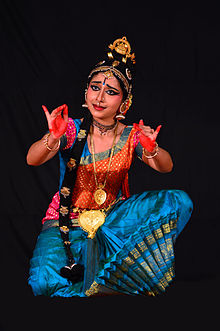
The Indian art of dance as taught in these ancient books, according to Ragini Devi, is the expression of inner beauty and the divine in man.[150] It is a deliberate art, nothing is left to chance, each gesture seeks to communicate the ideas, each facial expression the emotions.


In addition to the formal arts of dance, Indian regions have a strong free form, folksy dance tradition. Some of the

Drama
-
Andhra, with roots dating back to 3rd century BCE.
-
Kerala, India
-
Rasa lila theatrical performance in Manipuri dance style
-
A street play (nukkad natak) in Dharavislums in Mumbai.
-
Tulunadu.
-
Koodiyattam performer Kapila Venu
Indian drama and theatre has a long history alongside its music and dance.
Puppetry
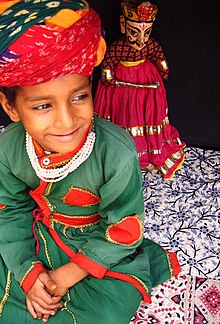
India has a long tradition of puppetry. In the ancient Indian epic Mahabharata there are references to puppets. Kathputli, a form of string puppet performance native to Rajasthan, is notable and there are many Indian ventriloquists and puppeteers. The first Indian ventriloquist, Professor Y. K. Padhye, introduced this form of puppetry to India in the 1920s and his son, Ramdas Padhye, subsequently popularised ventriloquism and puppetry. Ramdas Padhye's son, Satyajit Padhye is also a ventriloquist and puppeteer. Almost all types of puppets are found in India.
- String puppets
India has a rich and ancient tradition of string puppets or marionettes. Marionettes with jointed limbs controlled by strings allow far greater flexibility and are therefore the most articulate of the puppets. Rajasthan, Orissa, Karnataka and Tamil Nadu are some of the regions where this form of puppetry has flourished. The traditional marionettes of Rajasthan are known as
- Rod puppets
Rod puppets are an extension of glove-puppets, but are often much larger and supported and manipulated by rods from below. This form of puppetry now is found mostly in
- Glove puppets
Glove puppets are also known as sleeve, hand or palm puppets. The head is made of either
The tradition of glove puppets in India is popular in Uttar Pradesh, Orissa, West Bengal and Kerala. In
Shadow play

Shadow puppets are an ancient part of India's culture and art, particularly regionally as the keelu bomme and
During the 19th century and early parts of the 20th century of the colonial era, Indologists believed that shadow puppet plays had become extinct in India, though mentioned in its ancient Sanskrit texts.[160] In the 1930s and thereafter, states Stuart Blackburn, these fears of its extinction were found to be false as evidence emerged that shadow puppetry had remained a vigorous rural tradition in central Kerala mountains, most of Karnataka, northern Andhra Pradesh, parts of Tamil Nadu, Odisha and southern Maharashtra.[160] The Marathi people, particularly of low caste, had preserved and vigorously performed the legends of Hindu epics as a folk tradition. The importance of Marathi artists is evidenced, states Blackburn, from the puppeteers speaking Marathi as their mother tongue in many non-Marathi speaking states of India.[160]
According to Beth Osnes, the tholu bommalata shadow puppet theatre dates back to the 3rd century BCE, and has attracted patronage ever since.[163] The puppets used in a tholu bommalata performance, states Phyllis Dircks, are "translucent, lusciously multicolored leather figures four to five feet tall, and feature one or two articulated arms".[164] The process of making the puppets is an elaborate ritual, where the artist families in India pray, go into seclusion, produce the required art work, then celebrate the "metaphorical birth of a puppet" with flowers and incense.[165]
The tholu pava koothu of Kerala uses leather puppets whose images are projected on a backlit screen. The shadows are used to creatively express characters and stories in the Ramayana. A complete performance of the epic can take forty-one nights, while an abridged performance lasts as few as seven days.[166] One feature of the tholu pava koothu show is that it is a team performance of puppeteers, while other shadow plays such as the wayang of Indonesia are performed by a single puppeteer for the same Ramayana story.[166] There are regional differences within India in the puppet arts. For example, women play a major role in shadow play theatre in most parts of India, except in Kerala and Maharashtra.[160] Almost everywhere, except Odisha, the puppets are made from tanned deer skin, painted and articulated. Translucent leather puppets are typical in Andhra Pradesh and Tamil Nadu, while opaque puppets are typical in Kerala and Odisha. The artist troupes typically carry over a hundred puppets for their performance in rural India.[160]
Music
Music is an integral part of India's culture. Natyasastra, a 2000-year-old Sanskrit text, describes five systems of taxonomy to classify musical instruments.[169] One of these ancient Indian systems classifies musical instruments into four groups according to four primary sources of vibration: strings, membranes, cymbals, and air. According to Reis Flora, this is similar to the Western theory of organology. Archeologists have also reported the discovery of a 3000-year-old, 20-key, carefully shaped polished basalt lithophone in the highlands of Odisha.[170]
The oldest preserved examples of Indian music are the melodies of the
The current music of India includes multiple varieties of religious, classical, folk, filmi, rock and pop music and dance. The appeal of traditional classical music and dance is on the rapid decline, especially among the younger generation.
Prominent contemporary Indian musical forms included
Visual arts
Painting
-
APrehistoric cave painting in Bhimbetka rock shelters.
-
The Jataka tales from Ajanta Caves
-
Hindu iconography shown in Pattachitra
-
Raja Ravi Varma's Shakuntala (1870); oil on canvas
-
Bharat Mata by Abanindranath Tagore (1871–1951), a nephew of the poet Rabindranath Tagore, and a pioneer of the Bengal School of Art
-
A painting ofMeghanada after his victory over Indra by Raja Ravi Varma
-
Emperor Jahangir weighs Prince Khurram by Manohar Das, 1610–15, from Jahangir's own copy of the Tuzk-e-Jahangiri. The names of the main figures are noted on their clothes, and the artist shown at bottom.
Cave paintings from Ajanta, Bagh, Ellora and Sittanavasal and temple paintings testify to a love of naturalism. Most early and medieval art in India is Hindu, Buddhist or Jain. A freshly made coloured floor design (Rangoli) is still a common sight outside the doorstep of many (mostly South Indian) Indian homes. Raja Ravi Varma is one of the classical painters from medieval India.
Sculpture
-
Woman riding two bulls (bronze), fromKausambi, c. 2000–1750 BCE
-
TheNational Emblem of India, the most famous example of Mauryan art.
-
5th-century Buddha statue inKanheri caves, Mumbai
-
The Colossal 6 metres (20 ft) high trimurti sculpture at the Elephanta Caves
-
The iconic 57 ft high monolithic Statue of Gommateshwara, Shravanabelagola, 10th Century
-
The Dhyana Buddha is a statue ofAndhra
-
Bhutesvara Yakshis, reliefs from Mathura, 2nd century CE
-
Intricately carved sculptures on the exterior of one of the Khajuraho Group of Monuments
-
Kārttikeya, 11th century
-
TheTiruvalluvar
-
The Statue of Unity is the world's tallest statue, with a height of 182 metres (597 feet), located in the state of Gujarat.It depicts Indian statesman and independence activist Vallabhbhai Patel (1875–1950), who was the first deputy prime minister and home minister of independent India. It was inaugurated by the Prime Minister of India, Narendra Modi, on 31 October 2018.
The first
Sculptures produced in the northwest, in
Architecture
-
North Gate ofIndus valley civilisation archeological site built around the 3rd Millennium B.C in modern-day Gujarat.
-
Great Stupa of Sanchi, Madhya Pradesh built in the 3rd century BCE.
-
Ellora, Maharashtra, India.
-
The graniteRaja Raja Chola I.
-
Chennakesava Temple is a model example of the Hoysala architecture.
-
tallest Vimana among Hindu templesstanding at 344 feet. It was the tallest structure in the Indian subcontinent from 1558 CE to 1970 CE.
-
The rock-cut Shore Temple of the temples in Mahabalipuram, Tamil Nadu, 700–728. Showing the typical dravida form of tower.
-
Considered to be an "unrivalled architectural wonder", the Taj Mahal in Agra is a prime example of Indo-Islamic architecture. One of the world's seven wonders.[176]
-
Tawang Monastery in Arunachal Pradesh, was built in the 1600s and is the largest monastery in India and second largest in the world after the Potala Palace in Lhasa, Tibet.
-
Thakur Dalan of Itachuna Rajbari, Khanyan
-
Dravidian style in form of Tamil architecture of Meenakshi Temple
-
The Charminar, built in the 16th century by the Golconda Sultanate.
-
Amer Fort Entrance, Jaipur
-
Pachin Kari orPietra Dura on Tomb of I'timād-ud-Daulah
-
The Stone Chariot in Hampi
-
The Viceregal Lodge, now Rashtrapati Niwas, in Shimla designed by Henry Irwin in the Jacobethan style and built in the late 19th century.
-
Fort Dansborg, built by the 17th century Danish admiral Ove Gjedde, reminiscences of Danish India, Tharangambadi, Tamil Nadu
Indian architecture encompasses a multitude of expressions over space and time, constantly absorbing new ideas. The result is an evolving range of architectural production that nonetheless retains a certain amount of continuity across history. Some of its earliest production are found in the
During the period of the
The traditional system of
With the advent of Islamic influence from the west, Indian architecture was adapted to allow the traditions of the new religion, creating the
are creations of this era, and are often used as the stereotypical symbols of India.British colonial rule in India saw the development of
Indian architecture has influenced eastern and southeastern Asia, due to the spread of Buddhism. A number of Indian architectural features such as the temple mound or
Contemporary
Sports and martial arts
Sports
|
|
|
In 2011, India inaugurated a privately built Buddh International Circuit, its first motor racing circuit. The 5.14-kilometre circuit is in Greater Noida, Uttar Pradesh, near Delhi. The first Formula One Indian Grand Prix event was hosted here in October 2011.[193][194]
Indian martial arts
One of the best known forms of ancient Indian martial arts is the
Among eastern states, Paika akhada is a martial art found in Odisha. Paika akhada, or paika akhara, roughly translates as "warrior gymnasium" or "warrior school".[202] In ancient times, these were training schools of the peasant militia. Today's Paika akhada teach physical exercises and martial arts in addition to the Paika dance, performance art with rhythmic movements and weapons being hit in time to the drum. It incorporates acrobatic manoeuvres and use of the khanda (straight sword), patta (guantlet-sword), sticks, and other weapons.
In northern India, the
Indian martial arts techniques have had a profound impact on other martial arts styles across Asia. The 3rd-century BCE
Popular media
Television

Indian television started off in 1959 in New Delhi with tests for educational telecasts.
In 1991, the government liberated its markets, opening them up to cable television. Since then, there has been a spurt in the number of channels available. Today, the Indian small screen is a huge industry by itself and offers hundreds of programmes in almost all the regional languages of India. The small screen has produced numerous celebrities of their own kind, some even attaining national fame for themselves. TV soaps enjoy popularity among women of all classes. Indian TV also consists of Western channels such as Cartoon Network, Nickelodeon, HBO, and FX. In 2016 the list of TV channels in India stood at 892.[210]
Cinema
|
|
India has produced many cinema-makers like
Perceptions of Indian culture


India's diversity has inspired many writers to describe their perceptions of the country's culture. These writings paint a complex and often conflicting picture of the culture of India. India is one of the most ethnically and religiously diverse countries in the world. The concept of "Indian culture" is a very complex and complicated matter. Indian citizens are divided into various ethnic, religious, caste, linguistic and regional groups, making the realities of "Indianness" extremely complicated. This is why the conception of Indian identity poses certain difficulties and presupposes a series of assumptions about what concisely the expression "Indian" means. However, despite this vast and heterogeneous composition, the creation of some sort of typical or shared Indian culture results from some inherent internal forces (such as a robust Constitution, universal adult franchise, flexible federal structure, secular educational policy, etc.) and from certain historical events (such as Indian Independence Movement, Partition, wars against Pakistan, etc.) Hindu Sanskriti Ankh is an ancient series of books originally from northern part of India highlighting the Bharatiya Sanskriti, that is, the culture of India.
According to industry consultant Eugene M. Makar, for example, traditional Indian culture is defined by a relatively strict social hierarchy. He also mentions that from an early age, children are reminded of their roles and places in society.[211] This is reinforced, Makar notes, by the way, many believe gods and spirits have an integral and functional role in determining their life. Several differences such as religion divide the culture. However, a far more powerful division is the traditional Hindu bifurcation into non-polluting and polluting occupations. Strict social taboos have governed these groups for thousands of years, claims Makar. In recent years, particularly in cities, some of these lines have blurred and sometimes even disappeared. He writes important family relations extend as far as 1 gotra, the mainly patrilinear lineage or clan assigned to a Hindu at birth. In rural areas & sometimes in urban areas as well, it is common that three or four generations of the family live under the same roof. The patriarch often resolves family issues.[211]
Others have a different perception of Indian culture. According to an interview with C.K. Prahalad by Des Dearlove, author of many best selling business books, modern India is a country of very diverse cultures with many languages, religions, and traditions. Children begin by coping and learning to accept and assimilate in this diversity. Prahalad – who was born in India and grew up there – claimed, in the interview, that Indians, like everyone else in the world, want to be treated as unique, as individuals, want to express themselves and seek innovation.[212] In another report, Nancy Lockwood of Society for Human Resource Management, the world's largest human resources association with members in 140 countries, writes that in the past two decades or so, social change in India is in dramatic contrast to the expectations from traditional Indian culture. These changes have led to Indian families giving education opportunities to girls, accepting women working outside the home, pursuing a career, and opening the possibility for women to attain managerial roles in corporate India. Lockwood claims that change is slow, yet the scale of cultural change can be sensed from the fact that of India's 397 million workers, 124 million are now women. The issues in India with women empowerment are similar to those elsewhere in the world.[213]
According to Amartya Sen, the India born Nobel Laureate in Economics, the culture of modern India is a complex blend of its historical traditions, influences from the effects of colonial rule over centuries and current Western culture – both collaterally and dialectically. Sen observes that external images of India in the West often tend to emphasise the difference – real or imagined – between India and the West.[214] There is a considerable inclination in the Western countries to distance and highlight the differences in Indian culture from the mainstream of Western traditions, rather than discover and show similarities. Western writers and media usually misses, in important ways, crucial aspects of Indian culture and traditions. The deep-seated heterogeneity of Indian traditions, in different parts of India, is neglected in these homogenised descriptions of India. The perceptions of Indian culture, by those who weren't born and raised in India, tend to be one of at least three categories, writes Sen:
- Exoticist approach: it concentrates on the wondrous aspects of the culture of India. The focus of this approach of understanding Indian culture is to present the different, the strange and as Hegel put it, "a country that has existed for millennia in the imaginations of the Europeans."
- Magisterial approach: it assumes a sense of superiority and guardianship necessary to deal with India, a country that James Mill's historiography thought of as grotesquely primitive culture. While a great many British observers did not agree with such views of India, and some non-British ones did, it is an approach that contributes to some confusion about the culture of India.
- Curatorial approach: it attempts to observe, classify and record the diversity of Indian culture in different parts of India. The curators do not look only for the strange, are not weighed by political priorities, and tend to be freer from stereotypes. The curatorial approach, nevertheless, has an inclination to see Indian culture as more special and extraordinarily interesting than it actually may be.
The curatorial approach, one inspired by a systematic curiosity for the cultural diversity of India within India, is mostly absent.
Susan Bayly, in her book, observes that there is a considerable dispute in India and Orientalist scholars on perceived Indian culture. She acknowledges that many dispute claims of the pervasiveness of caste and strict social hierarchy in modern India. Bayly notes that much of the Indian subcontinent was populated by people for whom the formal distinctions of caste and strict social hierarchies were of only limited importance in their lifestyles.[215]
According to Rosser, an American sociologist, Americans of South Asian origins feel the Western perception of the culture of India has numerous stereotypes. Rosser notes that the discourse in much of the United States about the culture of India is rarely devoted to independent India. People quickly make sweeping and flawed metaphysical assumptions about its religion and culture but are far more circumspect when evaluating civil society and political culture in modern India. It is as if the value of South Asia resides only in its ancient contributions to human knowledge whereas its pathetic attempts to modernise or develop are to be winked at and patronised.[216] Rosser conducted numerous interviews and summarised the comments. The study reports a stark contrast between Western perceptions of the culture of India, versus the direct experience of the interviewed people. For example:
The presentation of South Asians is a standard pedagogic approach which runs quickly from the "Cradle of Civilisation"—contrasting the Indus Valley with Egypt and Mesopotamia—on past the Aryans, who were somehow our ancestors— to the poverty-stricken, superstitious, polytheistic, caste-ridden Hindu way of life ... and then somehow magically culminates with a eulogy of Mahatma Gandhi. A typical textbook trope presents standard Ancient India Meets the Age of Expansion Approach with a colour photo of the Taj Mahal. There may be a sidebar on ahimsa or a chart of connecting circles graphically explaining samsara and reincarnation or illustrations of the four stages of life or the Four Noble Truths. Amid the dearth of real information, there may be found an entire page dedicated to a deity such as Indra or Varuna, who admittedly are rather an obscure vis-à-vis the beliefs of most modern Hindus.
— A South Asian in America[216]
There is new debate arising as to whether or not Indian culture is decaying.[217]
See also
References
Citations
- ^ ISBN 978-0-8021-4558-1, see Introduction and Chapters 3 through 11
- ^ ISBN 81-89833-18-9
- ISBN 978-81-206-0772-9. Archivedfrom the original on 26 March 2023. Retrieved 26 October 2021.
It has been further proved that not only linguistic but also certain cultural and political facts of ancient India, can be explained by Austroasiatic (Mon-Khmer) elements.
- ^ "How rice farming may have spread across the ancient world". www.science.org. Archived from the original on 26 October 2021. Retrieved 26 October 2021.
- PMID 20978040.
- PMID 26482917.
- ISSN 1674-4918.
- ^ "British legacy alive and kicking in India". Reuters. 15 August 2007. Archived from the original on 9 April 2022. Retrieved 9 April 2022.
- ^ Adams, C. J., Classification of religions: Geographical Archived 14 December 2007 at the Wayback Machine, Encyclopædia Britannica, 2007. Accessed: 15 July 2010
- from the original on 27 September 2020. Retrieved 1 February 2019.
- ^ Houtsma 1936, p. 100, Volume 2
- ^ Stepaniants Marietta, 2002, The Encounter of Zoroastrianism with Islam, journal=Philosophy East and West, volume 52, issue 2, University of Hawai'i Press, page 163.
- ^ Affolter, Friedrich W. (2005). "The Specter of Ideological Genocide: The Bahá'ís of Iran" (PDF). War Crimes, Genocide and Crimes Against Humanity. 1 (1): 75–114. Archived (PDF) from the original on 5 January 2015. Retrieved 18 April 2018.
- ^ Mottahedeh, Roy, The Mantle of the Prophet : Religion and Politics in Iran, One World, Oxford, 1985, 2000, p.238
- ISBN 9780197136003.
- ISBN 9780415966924
- ^ "Under Persian rule". BBC. Archived from the original on 25 November 2020. Retrieved 16 December 2009.
- ^ "Desh Pardesh: The South Asian Presence in Britain", p. 252, by Roger Ballard
- ^ "Situation of Baha'is in Iran". Archived from the original on 27 May 2011. Retrieved 18 April 2018.
- OCLC 56413341. Archived from the originalon 20 November 2012.
- ISBN 1-55022-743-2p. 174
- ISBN 978-81-206-0772-9. Archivedfrom the original on 26 March 2023. Retrieved 26 October 2021.
It has been further proved that not only linguistic but also certain cultural and political facts of ancient India, can be explained by Austroasiatic (Mon-Khmer) elements.
- ^ "How rice farming may have spread across the ancient world". www.science.org. Archived from the original on 26 October 2021. Retrieved 26 October 2021.
- ISBN 978-81-224-1587-2.
- ^ Southeast Asia: A Historical Encyclopedia, from Angkor Wat to East Timor, by Keat Gin Ooi p.642
- ^ Hindu-Buddhist Architecture in Southeast Asia by Daigorō Chihara p.226
- ISBN 978-0-521-88782-3. Archivedfrom the original on 8 March 2021. Retrieved 28 September 2018. Lange: "Greater Persia (including Khwārazm, Transoxania, and Afghanistan)."
- ISBN 978-0-520-05771-5.
- ISBN 978-1-55970-803-6.
- ISBN 978-1-55490-276-7. Retrieved 5 December 2013.
- ^ ISBN 978-1-934145-00-5.
- ^ "Non Resident Nepali – Speeches". Nrn.org.np. Archived from the original on 25 December 2010. Retrieved 1 August 2010.
- ^ "BBCVietnamese.com". Bbc.co.uk. Archived from the original on 3 April 2015. Retrieved 1 August 2010.
- ^ "Religions of the world: numbers of adherents; growth rates". Religioustolerance.org. Archived from the original on 25 January 2021. Retrieved 1 August 2010.
- ^ S2CID 156206888.
- ^ a b "India has 79.8% Hindus, 14.2% Muslims, says 2011 census data on religion". First Post. 26 August 2015. Retrieved 22 September 2015.
- ^ ISBN 978-0-415-94024-5.
- ISBN 978-0857284334, pages 26–29
- ISBN 978-0199812615, page 50 with footnote 3
- ISBN 978-8120816077, page 67;, Appendix Note VII – Hindu Materialism: The Charvaka System; William Blackwood, London;
Roy W Perrett (1984), The problem of induction in Indian philosophy Archived 14 December 2020 at the Wayback Machine, Philosophy East and West, 34(2): 161–174;
(Bhattacharya 2011, pp. 21–32);
(Radhakrishnan & Moore 1957, pp. 187, 227–234);
Robert Flint, Anti-theistic theories, p. 463, at Google Books - doi:10.1111/j.1467-9744.2012.01274.x. Quote (page 557): "Aside from nontheistic schools like the Samkhya, there have also been explicitly atheistic schools in the Hindu tradition. One virulently anti-supernatural system is/was the so-called Charvaka school.",
- ISBN 978-81-208-0899-7. Retrieved 9 April 2011.
- JSTOR 1397540.
- ISBN 978-0-691-01958-1.
- ISBN 978-0-313-35182-2. Retrieved 7 September 2013.
- ^ "Global Index Of Religion And Atheism" (PDF). WIN-Gallup. Archived from the original (PDF) on 16 October 2012. Retrieved 3 September 2013.
- ^ a b Oxford Dictionary of World Religions, p. 259
- ^ Ben-Ami Scharfstein (1998), A comparative history of world philosophy: from the Upanishads to Kant, Albany: State University of New York Press, pp. 9-11
- ^ Flood 1996, pp. 82, 224–49
- ^ For an overview of this method of classification, with detail on the grouping of schools, see: Radhakrishnan & Moore 1957
- ^ Cowell and Gough, p. xii.
- ^ Nicholson 2010.
- ^ Chatterjee and Datta, p. 5.
- ^ p 22, The Principal Upanisads, HarperCollins, 1994
- ^ Clarke 2006, p. 209.
- ^ "Indian Families". Facts About India. Archived from the original on 30 July 2011. Retrieved 11 October 2011.
- S2CID 225105434.
- ^ ISBN 978-81-7022-448-8.
- JSTOR 2754275.
Autumn, 1966
- ^ Verma, Suman; Saraswathi, T.S. (2002). Adolescence in India. Rawat Publications. p. 112.
- ^ Heitzman, James. "India: A Country Study". US Library of Congress. Archived from the original on 9 May 2012. Retrieved 26 December 2012.
- ^ Women and men in India 2012 Archived 12 October 2013 at the Wayback Machine CSO/Census of India 2011, Government of India, pp xxi
- ^ K. Sinha Nearly 50% fall in brides married below 18 Archived 30 July 2019 at the Wayback Machine The Times of India (10 February 2012)
- ^ Heitzman, James. "India: A Country Study". US Library of Congress. Archived from the original on 20 May 2011. Retrieved 26 December 2012.
- ^ Agarwal, Bina (25 September 2005). "Landmark step to gender equality". The Hindu. Archived from the original on 1 October 2007.
- ^ "Avoid disputes, write a will". The Times of India. 4 August 2004. Archived from the original on 2 April 2020. Retrieved 19 February 2012.
- ^ "India moves to make it easier for couples to divorce". BBC News. 10 June 2010. Archived from the original on 21 August 2020. Retrieved 21 July 2018.
- ^ "Marriage and Divorce data by Country – United Nations database". Archived from the original on 31 July 2020. Retrieved 20 February 2012.
- ^ Pisharoty, Sangeeta (15 May 2010). "Marriages are in trouble". The Hindu newspaper. Archived from the original on 24 November 2012. Retrieved 19 February 2012.
- ^ Divorce soars in India's middle class
- ^ Banerji, Manjistha; Martin, Steven; Desai, Sonalde (2008). "Is Education Associated with a Transition towards Autonomy in Partner Choice? A Case Study of India" (PDF). University of Maryland & NCAER. Archived from the original (PDF) on 3 March 2016.
- ^ David Pilling (6 June 2014) Review – ‘India in Love’, by Ira Trivedi; ‘Leftover Women’, by Leta Hong Archived 28 September 2014 at the Wayback Machine The Financial Times
- ^ Sari nights and henna parties Archived 5 March 2016 at the Wayback Machine, Amy Yee, The Financial Times, 17 May 2008
- ^ India's love affair with gold Archived 8 August 2013 at the Wayback Machine, CBS News, 12 February 2012
- ISBN 978-81-208-0396-1, pages 153–233
- ^ ISBN 978-0-8239-3179-8, Page 427
- ^ History of Dharmasastra, Vaman Kane (1962)
- ISBN 978-81-7154-206-2, see pages 164–165
- ^ Three Days of a Traditional Indian Muslim Wedding Archived 21 February 2020 at the Wayback Machine, zawaj.com
- ^ Diwali 2013: Hindu Festival Of Lights Celebrated All Over The World Archived 17 August 2016 at the Wayback Machine Nadine DeNinno, International Business Times (November 02 2013)
- ^ James G. Lochtefeld 2002, p. 208.
- ^ "Nagaland's Hornbill Festival". Archived from the original on 9 December 2018. Retrieved 9 December 2018.
- ^ a b "Central Government Holidays" (PDF). Government of India. 2010. Archived (PDF) from the original on 9 October 2012. Retrieved 11 January 2012.
- ^ Reporter, B. S. (26 August 2015). "India's population at 1.21 billion; Hindus 79.8%, Muslims 14.2%". Business Standard India. Archived from the original on 24 April 2021. Retrieved 18 February 2021.
- ^ Namaste Archived 30 August 2017 at the Wayback Machine Douglas Harper, Etymology Dictionary
- ^ Ying, Y. W., Coombs, M., & Lee, P. A. (1999), the Family intergenerational relationship of Asian American adolescents, Cultural Diversity and Ethnic Minority Psychology, 5(4), pp 350–363
- ^ Lawrence, J. D. (2007), The Boundaries of Faith: A Journey in India, Homily Service, 41(2), pp 1–3
- ^ Cf. Messner, W. (2013). India – Intercultural Skills. A Resource Book for Improving Interpersonal Communication and Business Collaboration. Bangalore: Createspace, p. 92.
- ^ Symbolism in Indian culture Archived 9 May 2006 at the Wayback Machine
- ISBN 978-0-415-93919-5.
- ^ "The constitution of India" (PDF). Archived from the original (PDF) on 22 April 2018. Retrieved 3 August 2020.
- from the original on 23 August 2022. Retrieved 23 August 2022.
- from the original on 23 August 2022. Retrieved 23 August 2022.
- ^ "Indians split over cow ban". Asia Times. 6 January 2012. Archived from the original on 5 January 2012.
{{cite web}}: CS1 maint: unfit URL (link) - ^ "Cow slaughter ban: Using sensitivities to politically polarising ends works against democracy". The Economic Times. 10 January 2012. Archived from the original on 9 March 2012. Retrieved 10 January 2012.
- ^ "Livestock and poultry: world markets and trade" (PDF). United States Department of Agriculture. October 2011. Archived from the original (PDF) on 11 October 2012. Retrieved 10 January 2012.
- ISBN 978-0-684-80001-1. Archivedfrom the original on 20 July 2017. Retrieved 12 January 2012.
- ^ "Interview with Atul Kochhar". Spice Diary. April 2011. Archived from the original on 28 December 2011. Retrieved 12 January 2012.
- ^ McGee, Harold (December 2010). "Zapping the holiday candy". Archived from the original on 12 January 2012. Retrieved 12 January 2012.
- ^ "Modern Spice" (PDF). Indian Cuisine. 2009. pp. 59–62. Archived from the original (PDF) on 16 September 2012. Retrieved 12 January 2012.
- ISBN 978-81-85067-89-6.
- ISBN 978-1-897959-50-3.
- ISBN 978-1-590-20297-5.
- ^ "Indian food now attracts wider market". Asia Africa Intelligence Wire. 16 March 2005. Archived from the original on 19 July 2012. Retrieved 1 June 2009.
- ^ Louise Marie M. Cornillez (Spring 1999). "The History of the Spice Trade in India". Archived from the original on 5 October 2012. Retrieved 1 June 2009.
- ^ "Meatless Monday: There's No Curry in India". Archived from the original on 16 April 2009.
- S2CID 143223986.
- ISBN 978-81-203-4170-8. Retrieved 28 June 2012.
- ]
- ^ ISBN 978-1-4496-1811-7. Retrieved 4 June 2012.
- ^ "Andhra Pradesh cuisine". Indianfoodforever.com. Archived from the original on 1 May 2012. Retrieved 4 June 2012.
- ^ "Dum Pukht cooking". Compendium of food terms. theflavoursofhistory.com. Archived from the original on 2 April 2012. Retrieved 4 June 2012.
- ^ ISBN 978-1-4401-1635-3.
- ISBN 978-1-85065-176-5.
- ISBN 978-0-203-40942-8.
- ISBN 1-85973-732-3
- ^ Jones, Sir Arbor (1824). Discourses delivered before the Asiatic Society: and miscellaneous papers, on the religion, poetry, literature, etc., of the nations of India. Printed for C. S. Arnold. p. 28. Archived from the original on 26 May 2022. Retrieved 15 November 2015.
- ^ ISBN 978-81-208-1767-8.
- ^ Zvelebil 1992, p. 12: "... the most acceptable periodisation which has so far been suggested for the development of Tamil writing seems to me to be that of A Chidambaranatha Chettiar (1907–1967): 1. Sangam Literature – 200BC to AD 200; 2. Post Sangam literature – AD 200 – AD 600; 3. Early Medieval literature – AD 600 to AD 1200; 4. Later Medieval literature – AD 1200 to AD 1800; 5. Pre-Modern literature – AD 1800 to 1900"
- ^ Maloney 1970, p. 610
- ^ Hobson-Jobson: The words English owes to India Archived 9 May 2018 at the Wayback Machine M.J. Campion, BBC News (11 July 2012)
- ^ Hobson-Jobson: A Glossary of Colloquial Anglo-Indian Words and Phrases Archived 5 April 2015 at the Wayback Machine Yule and Burnell (1903);
- For Anglo-Indian word database: Digital Searchable Version at University of Chicago Archived 11 February 2021 at the Wayback Machine
- See Wordnik link in: Happy Diwali Archived 22 June 2017 at the Wayback Machine The Economist (14 November 2012); Wordnik claims about 2000 English words are sourced from different Indian languages. Hobson-Jobson above lists over 2300 Indian words, as well as non-Indian words from East Asia, Persia and other regions in the British Empire that expanded English vocabulary.
- ^ a b Staal 1963, p. 272
- ^ Chatterji as cited in Staal 1963, p. 272
- ^ Shah 1998, p. 11
- ^ Keith 1998, p. 187
- ^ Kamath (2001), p. 5–6
- ^ (Wilks in Rice, B.L. (1897), p490)
- ^ Pai and Narasimhachar in Bhat (1993), p103
- ^ Mahadevan, Iravatham. "Early Tamil Epigraphy from the Earliest Times to the Sixth Century AD". Harvard University Press. Archived from the original on 19 July 2013. Retrieved 4 December 2020.
- ^ The word Isila found in the Ashokan inscription (called the Brahmagiri edict from Karnataka) meaning to shoot an arrow is a Kannada word, indicating that Kannada was a spoken language in the 3rd century BCE (Dr. D.L. Narasimhachar in Kamath 2001, p5)
- ^ Odia gets classical language status Archived 21 February 2014 at the Wayback Machine The Hindu
- ^ Schwarzschild (1972), Some Unusual Sound-Changes in Prākrit, Journal of the American Oriental Society, pp 100–104
- ^ Dash (2012). Soma-vamsi yayati in tradition and medieval Oriya literature, Studies in History, 28(2), pp 151–177
- ISBN 978-0-08-087774-7, archivedfrom the original on 24 March 2023, retrieved 19 September 2020,
Apabhramsha seemed to be in a state of transition from Middle Indo-Aryan to the New Indo-Aryan stage. Some elements of Hindustani appear ... the distinct form of the lingua franca Hindustani appears in the writings of Amir Khusro (1253–1325), who called it Hindwi[.]
- ISBN 9781482864038.
- PMID 19779445.
- PMID 15128876.
- ^ Language survey reveals diversity Archived 27 November 2014 at the Wayback Machine, The Hindu, Shiv Sahay Singh (22 July 2013)
- ^ Dutt 2004, p.198
- ^ Brockington 2003
- ^ Brockington (1998, p. 26)
- ^ Van Buitenen; The Mahabharata – 1; The Book of the Beginning. Introduction (Authorship and Date)
- JSTOR 3250226.
- ^ "Natyashastra" (PDF). Sanskrit Documents. Archived (PDF) from the original on 16 September 2012. Retrieved 12 January 2012.
- ^ a b Coormaraswamy and Duggirala (1917). The Mirror of Gesture. Harvard University Press. p. 4.
- ^ Natalia Lidova 2014.
- ^ Tarla Mehta 1995, pp. xxiv, 19–20.
- ISBN 978-81-208-0674-0.
- ^ ""South Asian arts: Techniques and Types of Classical Dance"". Archived from the original on 7 January 2008. Retrieved 2 June 2022.
- ^ "Indian Dance Videos: Bharatanatyam, Kathak, Bhangra, Garba, Bollywood and various folk dances" Archived 20 August 2009 at the Wayback Machine
- ^ "India – Kalai Kaviri and Christu Dance Centre". International Christian Dance Fellowship. 2010. Archived from the original on 16 November 2012.
- Māni Mādhava Chākyār (1996). Nātyakalpadrumam. Sangeet Natak Akademi, New Delhi. p. 6.
- ^ K. A. Chandrahasan, In pursuit of excellence (Performing Arts) Archived 13 November 2012 at the Wayback Machine, "The Hindu", Sunday 26 March 1989
- ^ Mani Madhava Chakkyar: The Master at Work (film- English), Kavalam N. Panikar, Sangeet Natak Akademi, New Delhi, 1994
- ^ Lopes, Rui Oliveira. (2016) "A new light on the shadows of heavenly bodies. Indian shadow puppets: from still paintings to motion pictures". Religion and the Arts, vol. 20, no. 1-2, pp. 160-196. DOI: 10.1163/15685292-02001008
- ISBN 0-415-93919-4.
- ISBN 978-0-87436-795-9.
- ^ ISBN 978-0-415-93919-5.
- ISBN 0-8122-1337-8.
- ^ Stuart Blackburn (1998), Looking Across the Contextual Divide: Studying Performance in South India, South Asia Research, Volume 18, Issue 1, pages 1-11, Quote: "If performance is the cultural organisation of behaviour, it is interesting that these cultural forms vary so widely from area to area. To return to south India, tales are told and songs sung throughout the region, but the same is not true for long narrative singing (epic and the like), or for dance, or for drama; even masks, so widespread in Kerala and other parts of south India, are not significant in Tamil culture."
- ISBN 978-0-87436-795-9.
- ISBN 978-0-7864-1896-1.
- ISBN 978-0-262-52293-9.
- ^ ISBN 978-0-87436-795-9.
- ISBN 978-81-208-0772-3.
- ^ Rowell 2015, pp. 13–14.
- ISBN 978-0-8240-4946-1.
- ^ P. Yule; M. Bemmann (1988). "Klangsteine aus Orissa-Die frühesten Musikinstrumente Indiens?". Archaeologia Musicalis. 2 (1): 41–50. Archived from the original on 1 June 2012. Retrieved 10 January 2012.
- ISBN 978-90-04-03978-0.
- ^ A Study of Dattilam: A Treatise on the Sacred Music of Ancient India, 1978, p. 283, Mukunda Lāṭha, Dattila
- ^ "Plans to start India music awards". BBC News. 10 December 2009. Archived from the original on 27 January 2020. Retrieved 2 May 2010.
- ISBN 978-1-85109-636-7.
- ^ Kamath (2003), p. 283
- ISBN 978-1-74104-308-2.
- ^ Centre, UNESCO World Heritage. "Dholavira: A Harappan City - UNESCO World Heritage Centre". whc.unesco.org. Archived from the original on 15 May 2020. Retrieved 17 November 2018.
- ^ Centre, UNESCO World Heritage. "Rani-ki-Vav (the Queen's Stepwell) at Patan, Gujarat". whc.unesco.org. Archived from the original on 26 December 2018. Retrieved 17 November 2018.
- ^ Centre, UNESCO World Heritage. "Fatehpur Sikri". whc.unesco.org. Archived from the original on 14 May 2011. Retrieved 17 November 2018.
- ^ Centre, UNESCO World Heritage. "Taj Mahal". whc.unesco.org. Archived from the original on 15 March 2021. Retrieved 17 November 2018.
- ^ Centre, UNESCO World Heritage. "Red Fort Complex". whc.unesco.org. Archived from the original on 3 August 2009. Retrieved 17 November 2018.
- ^ Centre, UNESCO World Heritage. "Bahá'í House of Worship at New Delhi - UNESCO World Heritage Centre". whc.unesco.org. Archived from the original on 26 August 2016. Retrieved 17 November 2018.
- ^ "No records to state hockey as national game". Hindustan Times. 2 August 2012. Archived from the original on 5 January 2013. Retrieved 1 March 2013.
- ^ a b Gooptu, S (2004). "Cricket or cricket spectacle? Looking beyond cricket to understand Lagaan". The International Journal of the History of Sport.
- ^ a b Karafin, Amy; Mahapatra, Anirban (2009). South India. Lonely Planet. p. 69.
- ^ "Mohun Bagan vs East Bengal: India's all-consuming rivalry". FIFA. Archived from the original on 22 November 2011. Retrieved 7 December 2011.
- ^ Leibs (2004), p. 92
- ^ Robinson & Estes (1996), p. 34
- OCLC 13472872.
- ^ Bird 1893, p. 63
- ^ "Polo History". Archived from the original on 28 March 2009. Retrieved 2 January 2019.
- ^ "Manipur Polo – Indianpolo.com, polo, polo in india". Indianpolo.com. 25 March 2007. Archived from the original on 11 February 2019. Retrieved 25 January 2012.
- ^ "Buddh International Circuit unveiled amidst cheers" Archived 30 April 2016 at the Wayback Machine 19 October 2011, Zee News
- ^ "India: Friday practice – selected team and driver quotes". Formula1.com. Formula One Administration. 28 October 2011. Archived from the original on 4 July 2014. Retrieved 28 October 2011.
- ^ James Haughton Woods (1914). The Yoga System of Pantanjali, see Book First: Concentration. Harvard University Press.
- ISBN 978-0-471-74937-0.
- ^ Zarrilli, Phillip B. "Actualizing Power and Crafting a Self in Kalarippayattu" (PDF). Journal of Asian Martial Arts. Archived from the original (PDF) on 28 June 2007. Retrieved 3 February 2019.
- ^ ISBN 978-0-19-563940-7.
- ISBN 9789384318680.
- ^ a b Raj, J. David Manuel (1977). The Origin and the Historical Development of Silambam Fencing: An Ancient Self-Defence Sport of India. Oregon: College of Health, Physical Education and Recreation, Univ. of Oregon. pp. 44, 50, 83.
- ISBN 978-1-57607-150-2.
- ^ "Paika Akhada". Indian Association of Kickboxing Organisations. Archived from the original on 12 July 2011. Retrieved 9 February 2013.
- ISBN 978-1-59928-979-3.
- ISBN 978-0-9677546-2-8.
- ^ J. R. Svinth (2002). A Chronological History of the Martial Arts and Combative Sports. Archived 28 December 2010 at the Wayback Machine Electronic Journals of Martial Arts and Sciences
- ^ Cephas, Shawn (Winter 1994). "The Root of Warrior Priests in the Martial Arts". Kungfu Magazine.
- ^ "A Snapshot of Indian Television History". Indian Television Dot Com Pvt Ltd. Archived from the original on 16 June 2012. Retrieved 1 June 2006.
- ^ "INDIA". The Museum of Broadcast Communications. 2002. Archived from the original on 25 August 2012. Retrieved 26 January 2012.
- ISBN 978-0-252-09958-8.
- ^ "Total of television channels in India rises to 892, with three cleared in June". Indian Television Dot Com. 9 July 2016. Archived from the original on 5 August 2020. Retrieved 18 April 2020.
- ^ ]
- ^ Dearlove, Des (Spring 2009). "On the verge of something extraordinary". Business Strategy Review: 17–20. Archived from the original on 10 May 2013. Retrieved 9 January 2012.
- ^ Lockwood, Nancy (2009). "Perspectives on Women in Management in India" (PDF). Society for Human Resource Management. Archived from the original (PDF) on 5 March 2012. Retrieved 9 January 2012.
- ISBN 978-0-312-42602-6.
- ISBN 978-0-521-79842-6.
- ^ a b "Stereotypes in Schooling: Negative Pressures in the American Educational System on Hindu Identity Formation". Teaching South Asia, A Journal of Pedagogy. 1 (1): 23–76. Winter 2001. Archived from the original on 8 December 2015.
- ^ Pateriya, Gaurav (2023). "Is Indian culture decaying?Age". Cultural India. Archived from the original on 21 January 2023. Retrieved 21 January 2023.
Works cited
- ISBN 978-0-85728-433-4.
- Brockington, John (2003), "The Sanskrit Epics", in Flood, Gavin (ed.), Blackwell companion to Hinduism, ISBN 0-631-21535-2
- ISBN 978-0-7007-1185-7
- Dutt, Romesh C. (2004). Ramayana. Kessinger Publishing. p. 208. ISBN 9781419143878.
- Flood, Gavin (1996). An Introduction to Hinduism. Cambridge: Cambridge University Press.
- Houtsma, Martijn Theodoor (1936), First Encyclopaedia of Islam 1913-1936: E.J.Brill's, BRILL, ISBN 9789004097964
- Keith, Arthur Berriedale (1998). The Sanskrit Drama. Motilal Banarsidass Publ. ISBN 978-81-208-0977-2.
- Natalia Lidova (2014). Natyashastra. Oxford University Press. .
- James G. Lochtefeld (2002). The Illustrated Encyclopedia of Hinduism: A-M. The Rosen Publishing Group. ISBN 978-0-8239-3179-8.
- Maloney, Clarence (May 1970). "The Beginnings of Civilization in South India". The Journal of Asian Studies. 29 (3): 603–616. S2CID 162291987.
- Tarla Mehta (1995). Sanskrit Play Production in Ancient India. Motilal Banarsidass. ISBN 978-81-208-1057-0.
- Nicholson, Andrew J. (2010), Unifying Hinduism: Philosophy and Identity in Indian Intellectual History, Columbia University Press
- Rowell, Lewis (2015). Music and Musical Thought in Early India. University of Chicago Press. ISBN 978-0-226-73034-9.
- Shah, Natubhai (1998). Jainism: The World of Conquerors. Sussex Academic Press. ISBN 978-1-898723-31-8.
- Staal, J. F. (May 1963). "Sanskrit and Sanskritization". The Journal of Asian Studies. 22 (3): 261–275. S2CID 162241490.
- Zvelebil, Kamil (1992), Companion studies to the history of Tamil literature, Leiden: Brill, ISBN 978-90-04-09365-2
Bibliography
- Ghose, Aurobindo. 1998. The foundations of Indian culture. Pondicherry: Sri Aurobindo Ashram.
- Lidova, Natalia (2014). Natyashastra. Oxford University Press. .
- Lidova, Natalia (1994). Drama and Ritual of Early Hinduism. Motilal Banarsidass. ISBN 978-81-208-1234-5.
- Williams, Drid (2004). "In the Shadow of Hollywood Orientalism: Authentic East Indian Dancing" (PDF). Visual Anthropology. 17 (1): 69–98. S2CID 29065670. Archived from the original(PDF) on 4 March 2016. Retrieved 1 August 2016.
- Mehta, Tarla (1995). Sanskrit Play Production in Ancient India. Motilal Banarsidass. ISBN 978-81-208-1057-0.
- ISBN 978-90-04-03978-0.
- Gupta, S. P., & Shastri Indo-Canadian Institute. (2011). The roots of Indian art: A detailed study of the formative period of Indian art and architecture, third and second centuries B.C., Mauryan and late Mauryan. Delhi: B.R. Publishing Corporation.
- Vatsyayan, Kapila (2001). Bharata, the Nāṭyaśāstra. Sahitya Akademi. ISBN 978-81-260-1220-6.
- Vatsyayan, Kapila (1977). Classical Indian dance in literature and the arts. Sangeet Natak Akademi.
- Public Broadcasting System, USA (2008). The story of India – history and culture Archived 18 August 2017 at the Wayback Machine
- Sharma, Ram Sharan (2005), ISBN 978-0-19-568785-9).
- Bajpai, Shiva (2011). The History of India – From Ancient to Modern Times Archived 24 June 2019 at the ISBN 978-1-934145-38-8)
- A.L. Basham, The Wonder That was India, ISBN 0-330-43909-X, Picador London
- Auboyer, Jeannine (2002). Daily Life in Ancient India, from 200 BC to 700 AD. (originally published in French in 1961), Phoenix Press, London ISBN 1-84212-591-5
- Dalmia, Vasudha and Rashmi Sadana (editors), The Cambridge Companion to Modern Indian Culture, Cambridge University Press, ISBN 978-0-521-51625-9
- Grihault, Nicki. Culture Smart! India: A Quick Guide to Customs and Etiquette. ISBN 1-85733-305-5.
- Henderson, Carol E. (2002). Culture and Customs of India Archived 30 October 2022 at the ISBN 0-313-30513-7.
- ISBN 0-7493-9920-1.
- Nilakanta Sastri, A history of South India from prehistoric times to the fall of Vijayanagar, Oxford University Press, ISBN 0-19-560686-8
- ISBN 0-14-010480-1
- Patra, Avinash (2012), The Spiritual Life and Culture of India Archived 30 October 2022 at the Wayback Machine, Oxford University Press, England.
Further reading
- Chattopadhyaya, D. P. (ed.). History of Science, Philosophy and Culture in Indian Civilization. Vol. 15-volum + parts Set. Delhi: Centre for Studies in Civilizations.
External links
- Union Ministry of Culture (archive): Links to some cultural sites and available grants for understanding the cultural diversity and society of India
- Union Ministry of Culture: Official Website
- India and World Cultural Heritage A UNESCO site describing cultural heritage sites of India
- India's intangible cultural heritage Another UNESCO site dedicated to Indian dance and other cultural heritage
- Indian Culture: Repository of culturally-relevant data hosted by/at the behest of the Union Ministry of Culture





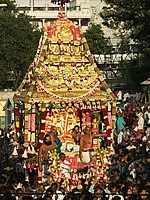
![Homes, buildings and temples are decorated with festive lights, diya, for Diwali, the festival of lights.[80]](http://upload.wikimedia.org/wikipedia/commons/thumb/5/5e/Deepawali-festival.jpg/180px-Deepawali-festival.jpg)





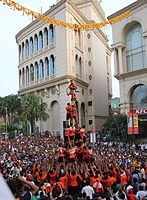
![Durga Puja is a multi-day festival in Eastern India that features elaborate temple and stage decorations (pandals), scripture recitation, performance arts, revelry, and processions.[81]](http://upload.wikimedia.org/wikipedia/commons/thumb/7/78/Durga_Puja_2015.JPG/180px-Durga_Puja_2015.JPG)
![The Hornbill Festival, Kohima, Nagaland. The festival involves colourful performances, crafts, sports, food fairs, games and ceremonies.[82]](http://upload.wikimedia.org/wikipedia/commons/thumb/a/ab/Angami_1863b.jpg/180px-Angami_1863b.jpg)

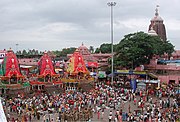

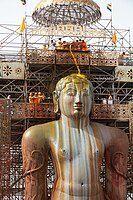
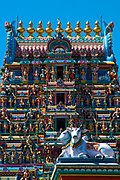






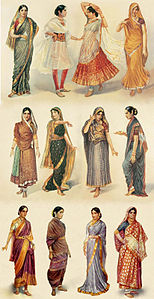



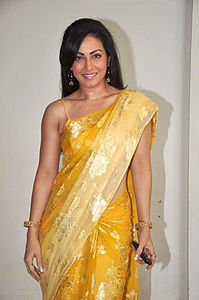

![Indian actress Priyanka Chopra wearing a lehenga and ghagra choli, exposing the midriff and navel, which has long been a fashion with Indian women in popular culture[117]](http://upload.wikimedia.org/wikipedia/commons/thumb/6/6e/Priyanka_on_the_ramp_for_Mijwan_fashion_show.jpg/205px-Priyanka_on_the_ramp_for_Mijwan_fashion_show.jpg)






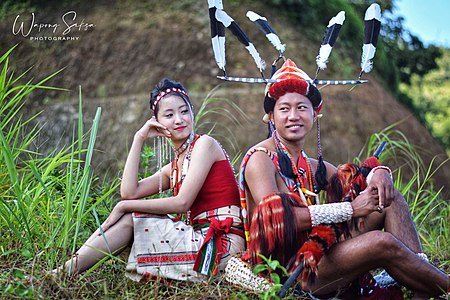

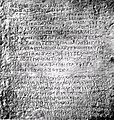
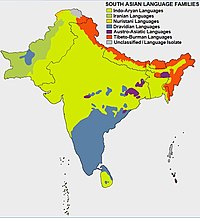






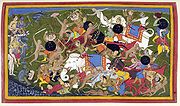
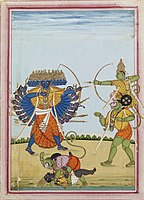
![Ilango Adigal is the author of Silappatikaram, one of the five great epics of Tamil literature.[145]](http://upload.wikimedia.org/wikipedia/commons/thumb/2/23/Puhar-ILango.jpg/133px-Puhar-ILango.jpg)





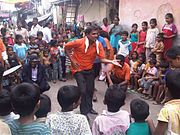

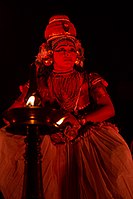




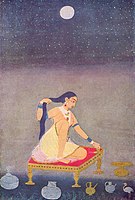


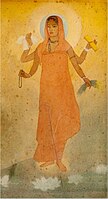



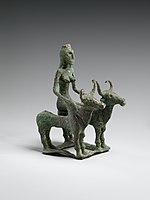
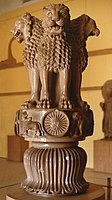
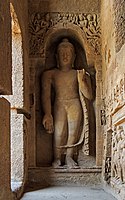




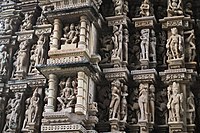

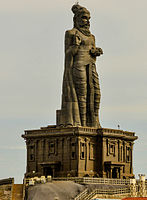
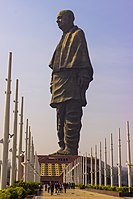






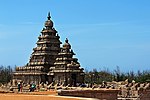
![Considered to be an "unrivalled architectural wonder", the Taj Mahal in Agra is a prime example of Indo-Islamic architecture. One of the world's seven wonders.[176]](http://upload.wikimedia.org/wikipedia/commons/thumb/d/da/Taj-Mahal.jpg/150px-Taj-Mahal.jpg)
